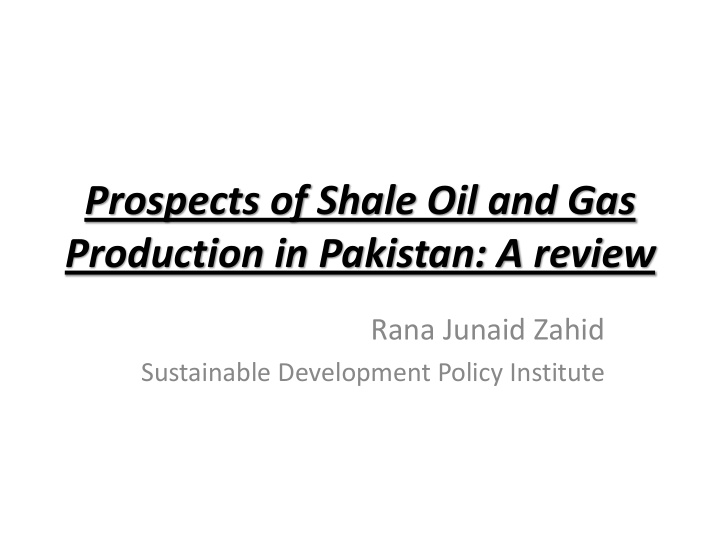



Prospects of Shale Oil and Gas Production in Pakistan: A review Rana Junaid Zahid Sustainable Development Policy Institute
Introduction • Shale are fine grained sedimentary rocks formed by the accumulation of sediments at the Earth’s surface and within bodies of water. • Shale gas is found in commonly occurring rock formations rich in organic matter. Scientists have been aware of these formations for almost 200 years. • The first Shale gas extraction was done in 1821 in a shallow, low pressure fracture in Fredonia, New York.
Shale oil and gas potential in the world
Shale oil and gas potential in the world
Shale oil & gas production in the world
Shale oil & gas production in the world • The United States is the first country to pioneer a profitable production of shale gas. In the US, shale gas production has increased exponentially: from 11 billion cubic meters (bcm) in 2000 to 138 bcm in 2010. In other words, shale gas has increased by 12.3 times in the last 10 years, which is 23% of the shale gas resource is 24.4-49.4 trillion cubic meters (tcm) only in the US. The shale gas resources are estimated to be enormous. Production rate of about 0.6 tcm per year, the current recoverable shale gas resource estimate could provide enough natural gas to supply the US for the next 41 to 82 years (some estimates claim more than a 100 years).
Energy mix in the world
Energy mix in Pakistan
Why Shale?
Global Technological aspects
Global Technological aspects
Global Technological aspects
Pakistan scenarios- Technology
Pakistan scenarios- Technology • Technological barriers are present during exploration, appraisal, development & production phases of shale • Drilling and other advanced machinery will be required that will be able to bore on deep depths.
Global Economic benefits • Shale gas production has the potential to transform the energy market in the United States and beyond. The United States has traditionally relied on imports, primarily from Canada, for its natural gas needs. The size of US shale plays and the recent investments in developing them could make the United States self-sufficient. In 2008, the country imported 13 percent of its natural gas supply. That figure is expected to drop to nearly 1 percent by 2035. There are signs that the United States is poised to become significant player in the global natural gas market. The United States has been working to repurpose some natural gas processing and conversion facilities, originally designed for imports, to handle exports of shale gas in the form of LNG.
Pakistan’s Economic benefits There are many reasons which force Pakistan to go for unconventional energy resources • Huge unmet gas demand • Fulfill its energy demand • Cheap transport fuel • Poor economic conditions • Technical person availability • Capacity to take over such project
Global Environmental aspects • Fracking faces serious challenges in drought-prone, high water-demand area • Risk will worsen as global climate disruption accelerates • Any thirsty industry faces uncertain future • Onsite runoff • Increased soil erosion
Global Environmental aspects • Threats to integrity of containment pits • Seismicity risk from wastewater disposal • Contamination of Water • Frack water storage in open containments a big risk for wildlife, domestic animals, • Volatilizing chemicals cause local air pollution, health impacts
Pak-Environmental aspects
Pak-Environmental aspects
Process Steps and Environmental Concerns Process Step: Site development and preparation 1. “Shale gas drilling takes up a larger land use footprint than conventional production” Process Step: Vertical drilling and effect on drinking water 2. “Hydraulic fracturing can have adverse effects on Drinking water” Process Step: Horizontal drilling No environmental concerns rise
Process Steps and Environmental Concerns Process Step: Hydraulic fracturing and water use 3. “Hydraulic fracturing uses enormous quantities of water” 4. “Hydraulic fracturing fluids contain dangerous chemicals that aren’t disclosed to the public” Process Step: Disposal of wastewater 5. “Hydraulic fracturing and associated wastewater disposal cause earthquakes” 6. “Disposal of wastewater harms the environment”
Process Steps and Environmental Concerns • Process Step: Well completion and abandonment • No environmental concerns rise • Concerns: Air emissions and regulations • 7. “Air emissions related to shale gas production are worse than those created by burning coal” • 8. “Shale gas extraction is not regulated”
Water; A Depleting natural resource in Pakistan
Water; A Depleting natural resource in Pakistan
Policy Recommendation • The shale industry must minimize the environmental consequences • The shale industry needs to develop technological solutions to minimize water use, minimize and report chemical use, and carefully monitor production sites.
Policy Recommendation • One working on fields should focus on ways to treat drilling and production wastes to reduce toxicity before their ultimate disposal. • A task force should be determine that conduct the Environmental Impact Assessments and that will take public into confident.
Policy Recommendation • The feasibility study should include following field work: Detailed Mapping of the area. Topographic study of the area. Seismic refraction study. River flow data. Weather data contain temperature, pressures, rain humidity. Water sampling and testing. Environmental study. Social impact. Identification of stake holders of the area.
Thank You
Recommend
More recommend